Volga-Volga Scene Analysis
https://www.youtube.com/watch?v=wUnZqtcrOlI
Above is a link to the full movie, Volga Volga (1938). Below are five scene analyses, each containing pertinent references to Stalinist musical ideology, including censorship, film theory, and the national agenda for folk music.
Scene One: Wagner is Boring and Strelka Unites the People
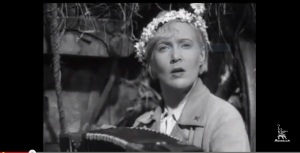
Strelka and her romantic interest Alyosha are on a ferry, when they break into a heated debate on the value of the classical music tradition, specifically Wagner. Alyosha, in order to refute Strelka’s claim that Wagner is “boring”, takes out his Sousaphone and plays a dignified excerpt from Tristan und Isolde. Although the piece itself in a concert setting would be much more complex, what comes across to film viewers are only a couple bland downbeats, along with what Peter Kupfer counts as 47 bars of rest (Kupfer, 543). In order to subvert bourgeois conceptions of the lofty high ground that Wagner had previously been held in, he is shown to be simple, and without substance when taken out of the canonical context of the concert hall. It’s here that Strelka first performs the song of the Volga to juxtapose the emptiness of Wagner to a full, emotional song performed with an accordion accompaniment.
Strelka and Alyosha are then stuck on a ferry crossing the river when the ferry cable snaps. In order to communicate with Bivalov on the shore, Strelka rallies everyone on the ferry to yell across the channel the message with her. I see this moment as harkens back to two messages about unification: one, the unification of people. The message itself is about wanting to participate in a national musical contest. Taking this concept of unification with the context of the message, one can easily see an agenda for broader participation in the arts. This scene happens directly after Alyosha claims that Strelka’s musical legitimacy is invalid. I believe this juxtaposition is purposeful as it immediately debunks Strelka’s illegitimacy to unite people in “song”. Although it was previously mentioned that she is the conductor of her folk music group, this scene demonstrates that she does in fact had the qualities to lead musically. Interestingly, the context of Strelka being a letter carrier doesn’t dissipate while she’s in this musical leadership role. Instead the message is put at the forefront, while her musical abilities are acting in a supporting role to this exchange. It’s in this sense that the other unification is made clear: not only is Strelka unifying the people, she’s also unifying the message, as she explains the message to be proclaimed, and then provides the chanting basis in which the others can join in.
Scene Two: Formal Fights Folk
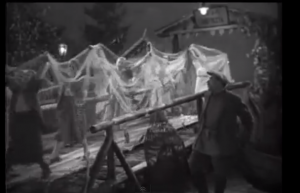
The second scene is about the town hoopla that occurs when Bivalov is forced to choose between the formal orchestra or Strelka’s folk group to represent the town at the Olympiad. In an attempt to prove that “the town does indeed have talent” every member of the village performs his/her own unique talent in a 7 minute sequence. This is not comprised of only those specifically in the folk music group. Also, it’s important to note that these talents are not solely musical, they also include multiple forms of dance (and also people on stilts at one point). This again shows the ideological stance that music is indeed for everyone, not only those who officially train themselves on an instrument, or even those affiliated with a folk music group. Everyone, at least in this idealized society, has something to contribute to the folk culture of the town.
Scene Three: Formal Fights Folk (on Water)
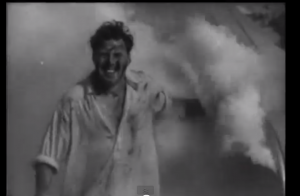
This scene follows the boat race that occurs when Strelka and her folk group refuse to not compete at the Olympiad. Much of the comedy in this scene is related to the easiness in harming the orchestra’s boat, such as a simple punch to a supporting beam and it completely breaking off. The boat seems more like a decoration than an actual, usable vehicle. When Bivalov and the others see Strelka approaching, they push it into high gear, so much that giant wafts of black smoke come barreling out of their boat. At moments it seems that the formalists make overtake Strelka, but those moments are fleeting. It’s visually clear that (the director) means to show the struggle in which formal music must go through in order to even keep up with the resurrection of folk music.
Scene Four: Formal Legitimizes Folk (on Water)
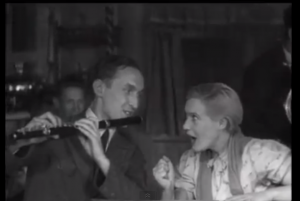
Strelka and her lover Alyosha attempt to meet with each other when their boats are docked, and humorously missing each other, they become stranded on each other’s respective boats. Strelka is given the opportunity to perform the Song of the Volga to the orchestra members, and they immediately begin composing an accompaniment. There are a few things I’d like to point out in this scene: One, the reception of Strelka by the orchestra. Unlike Alyosha, the orchestra doesn’t deny Strelka’s composing capability. Even though she is officially a letter carrier, performers are depicted as to not put this fact ahead of her musicality. Two: the form that collaboration takes. The accompaniment that is produced is written down. The distinction between formal and folk seems to be dissipating, as those already having musical legitimacy are now granting the folk tradition the ability to have the same legitimacy. The legitimacy that Strelka could not obtain on her own (exampled by the disregarding remarks of Alyosha and Bivalov when she first performs for them) is now granted by the classically trained orchestra members.
Scene Five: Strelka Wins the Olympiad
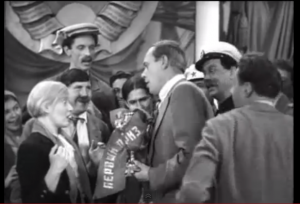
Strelka wins the competition because she successfully integrates her folk music into the greater Soviet culture. Despite this final scene culminating in the folk music group not performing until after the prize had been awarded to Strelka, this proves to be validating to the Soviet practice of folk music being brought back to Moscow after being written down by composers sent out to the countryside (Frolova-Walker, 343). Before performing Song of the Volga, Strelka admits to the crowd that it was she all along who wrote the song, not “Dunya the other Letter Carrier”. By acknowledging that her folk composition is hers, she can receive the acclaim that comes with producing a successful, Stalinist mass song.
Appendix
A. Excerpt of Translated Lyrics from The Song of the Volga (Volga-Volga, 92:16-97:00)
Many a Song has been written about the Volga
All were mirthless in the minor key
It was anguish that spawned those melodies.
Now it’s joy and happiness
sing a ringing and cheerful song
That we should show how strong we are.
May it reach our golden bright sun
May it reach everyone’s heart
We dispersed every dark thundercloud
Spring has come to our dear Motherland
Like the Volga our life is full-blooded
and this free life will not ever end.
Citations
Beumers, Brigit. “Soviet and Russian Blockbusters: A Question of Genre?” Slavic Review 62 (2003): 441-454.
Frolova-Walker. “National in Form, Socialist in Content: Musical Nation Building in the Soviet Republics.” Journal of the American Musicological Society 51 (1998) 331-271.
Kupfor, Peter. “Volga-Volga: “The Story of a Song,” Vernacular Modernism, and the Realization of Soviet Music.” The Journal of Musicology 30 (2013): 530-576.
Plamber, Jan. “Abolishing Ambiguity: Soviet Censorship Practices in the 1930s.” The Russian Review 60 (2001): 526-544.
Youngblood, Denise. “The Fate of Soviet Popular Cinema during the Stalin Revolution.” The Russian Review 50 (1991): 148-162.
Youtube. “Volga-Volga.” Last Modified March 30, 2011. https://www.youtube.com/watch?v=wUnZqtcrOlI.
